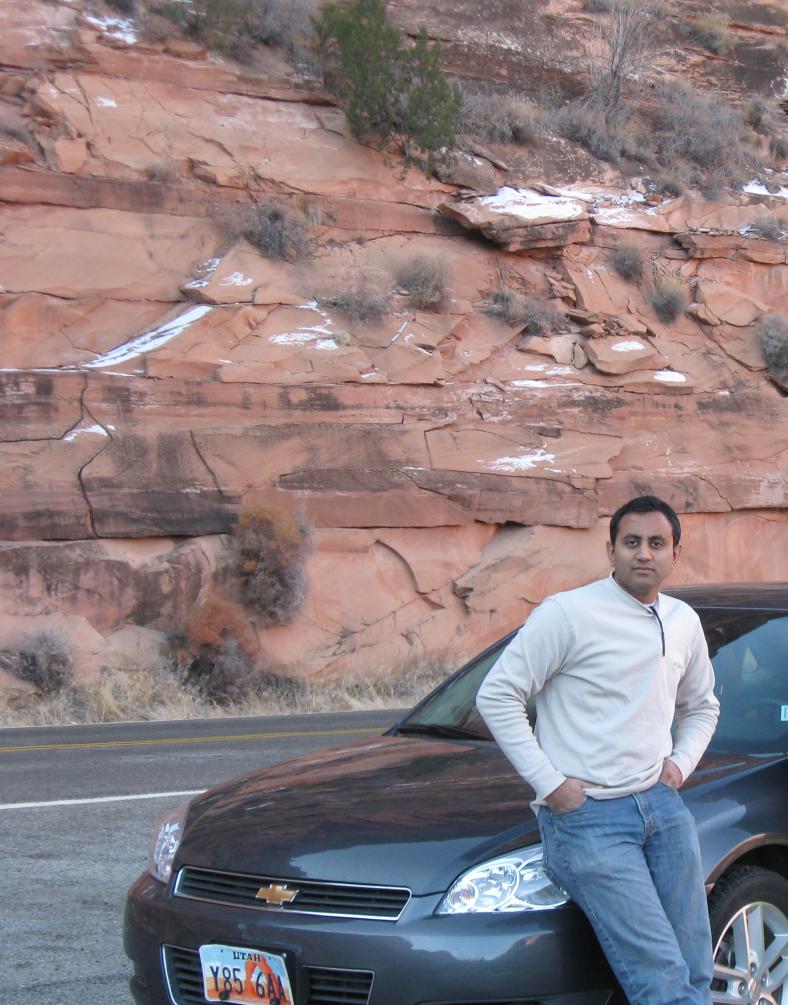LAB Announcements
Spotlight
Bhagirath Addepalli

Hometown: Hyderabad, India
Program: PhD (Graduated May 2012)
Current Position: Microsoft Program Manager
Research Interests: Fundamental and applied research in fluid dynamics, inverse and optimization techniques, and statistical modeling and analysis of data. Specifically, interests include: laboratory experiments, computational fluid dynamics, Lagrangian random-walk modeling, development of novel case-specific objective functionals (metrics) for inverse problems, development of efficient and robust optimization and inversion techniques spanning deterministic, stochastic (frequentist), and Bayesian methods, multiple criteria decision making (MCDM - Pareto optimality), linear and nonlinear regression techniques for stochastic modeling, statistical modeling of time series data, model selection in inverse problems.
Publications:
A) Journal Publications / Pre-prints:
a) Addepalli, B., K. Sikorski, E.R. Pardyjak and M.S. Zhdanov. Source characterization of atmospheric releases using stochastic search and regularized gradient optimization. Inverse Problems in Science and Engineering, 2011. 19(8): p. 1097-1124.
b) Addepalli, B. and E.R. Pardyjak. A pseudo-metric to handle zero measurements and predictions in atmospheric inverse-source problems. Under review. Submitted to Inverse Problems in Science and Engineering.
c) Addepalli, B. and E.R. Pardyjak. Investigation of flow structure in step-up street canyons. Ready to be submitted to Boundary Layer Meteorology. Pre-print available upon request.
d) Addepalli, B. and E.R. Pardyjak. Study of flow fields in asymmetric step-down street canyons. Ready to be submitted to Boundary Layer Meteorology. Pre-print available upon request.
e) Addepalli, B., E.R. Pardyjak, P. Willemsen and D.E. Johnson. Urban form optimization for air quality applications using simulated annealing and genetic algorithms. Ready to be submitted to Atmospheric Environment. Pre-print available upon request.
f) Addepalli, B. Markov Chain Monte Carlo annealing for atmospheric inverse-source problems. To be submitted to Inverse Problems in Science and Engineering. Pre-print available upon request.
B) Peer-reviewed Conference Publications:
a) Addepalli, B., K. Sikorski, E.R. Pardyjak and M.S. Zhdanov. Quasi-Monte Carlo, Monte Carlo, and regularized gradient optimization methods for source characterization of atmospheric releases. in Dagstuhl Seminar Proceedings 09391, Algorithms and Complexity for Continuous Problems. 2009. Dagstuhl, Germany: Schloss Dagstuhl - Leibniz-Zentrum fuer Informatik, Germany.
b) Addepalli, B. and E.R. Pardyjak. Study of flow fields in asymmetric step-down street canyons. in The International Workshop on Physical Modelling of Flow and Dispersion Phenomena (PHYSMOD). 2007. University of Orleans, France.
C) Conference Publications:
a) Pardyjak, E.R., Addepalli, B., et al., Impact of green infrastructure on urban microclimate and air quality, in the 8th International Conference on Urban Climate - ICUC 8. 2012: Dublin, Ireland.
b) Addepalli, B. and C. Sikorski, A note on objective functions for atmospheric inverse-source problems, in second National Conference in Advancing Tools and Solutions for Nuclear Material Detection. 2011: Salt Lake City, UT.
c) Addepalli, B. and C. Sikorski, Efficient adaption of simulated annealing and genetic algorithms to atmospheric inverse-source problems, in AIChE Annual Meeting. 2010: Salt Lake City, UT.
d) Addepalli, B. and C. Sikorski, Tools to characterize the source of hazardous releases, in 1st National Conference on Advancing Tools and Solutions for Nuclear Material Detection. 2010: Salt Lake City, UT.
e) Addepalli, B., M.J. Brown, E.R. Pardyjak and I. Senocak. Evaluation of the QUIC-URB wind model using wind-tunnel data for step-up street canyons, in Seventh Symposium on the Urban Environment. 2007: San Diego, CA.
f) Addepalli, B. and E.R. Pardyjak. 2D PIV Measurements of street canyon flow for buildings with varying angles and separation distances. in American Meteorological Society Sixth Symposium on the Urban Environment. 2006: Atlanta, GA.
D) Conference Presentations:
a) Addepalli, B., E.R. Pardyjak, P. Willemsen and D.E. Johnson. GPU-MCDM: A new module of the Quick Urban and Industrial Complex (QUIC) dispersion modeling system for urban form optimization. in the 8th International Conference on Urban Climate - ICUC 8. 2012: Dublin, Ireland.
b) Addepalli, B., E.R. Pardyjak, P. Willemsen and D.E. Johnson. Development of a multiple criteria decision making (MCDM) tool for urban form optimization. in 92nd AMS Annual Meeting. 2012: New Orleans, LA.
c) Addepalli, B., E.R. Pardyjak, P. Willemsen and D.E. Johnson. Urban form optimization for air quality applications using simulated annealing and genetic algorithms. in Ninth Symposium on the Urban Environment. 2010: Keystone, CO.
d) Addepalli, B., M.J. Brown, E.R. Pardyjak and I. Senocak. Investigation of the flow structure around step-up, step-down, deep canyon, and isolated tall building configurations using wind-tunnel PIV measurements, in Seventh Symposium on the Urban Environment. 2007: San Diego, CA.
e) Addepalli, B., E.R. Pardyjak and M.J. Brown. The effect of geometry on the wake structure of a surface mounted obstacle. in 60th Annual Meeting of the APS Divison of Fluid Dynamics. 2007: Salt Lake City, UT.
f) Addepalli, B. and E.R. Pardyjak. Experimental investigation of the effect of Reynolds number and HΔ value on flow fields in street canyons with cubical Buildings. in American Physical Society, 59th Annual Meeting of the APS Division of Fluid Dynamics. 2006: Tampa Bay, FL.
g) Addepalli, B. and E.R. Pardyjak. 2D PIV measurements of flow between a pair of model buildings with varying geometries. in American Physical Society, 58th Annual Meeting of the Division of Fluid Dynamics. 2005: Chicago, IL.
E) Technical Reports:
a) Addepalli, B., C. Sikorski and E.R. Pardyjak. Source Characterization of atmospheric releases using quasi-random sampling and gradient optimization. Report submitted to the School of Computing, University of Utah. Report number: UUCS 09-001.
b) Nelson, M., B. Addepalli, D. Boswell and M.J. Brown. QUIC Start Guide (v 4.5). Los Alamos National Labratory. LA-UR-07-2799.
Contact: addbugs@gmail.com
 Video demonstration of the measurement of SWE using the Differential Emissivity Disdrometer (DEID) and imaging for falling snowflakes using an SLR camera and laser for particle tracking velocimetry.
Video demonstration of the measurement of SWE using the Differential Emissivity Disdrometer (DEID) and imaging for falling snowflakes using an SLR camera and laser for particle tracking velocimetry. 

